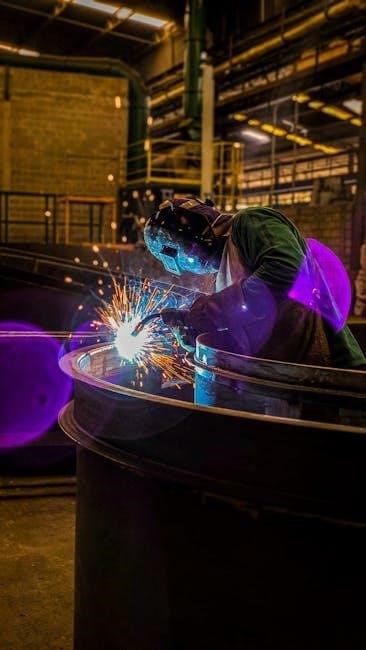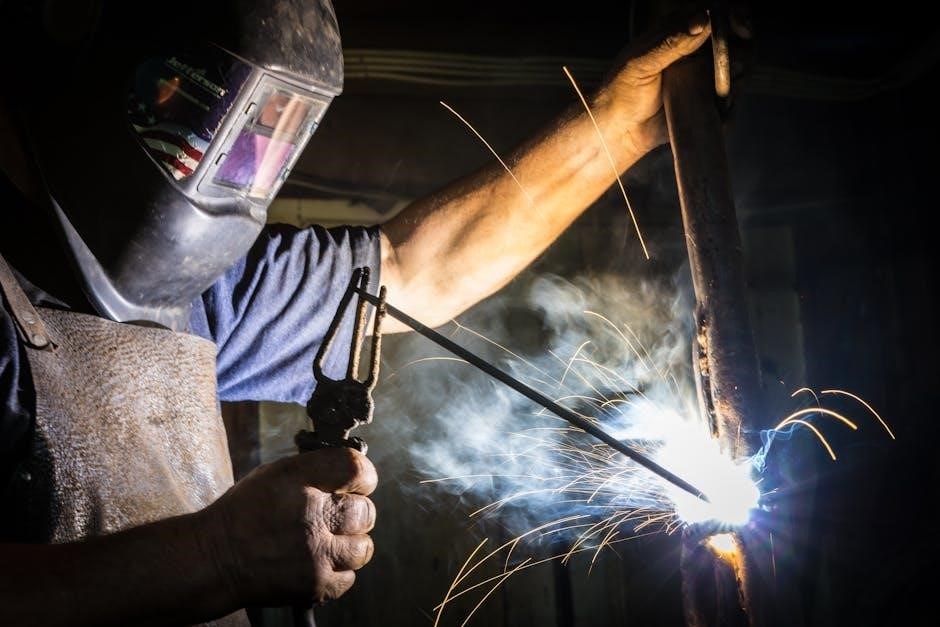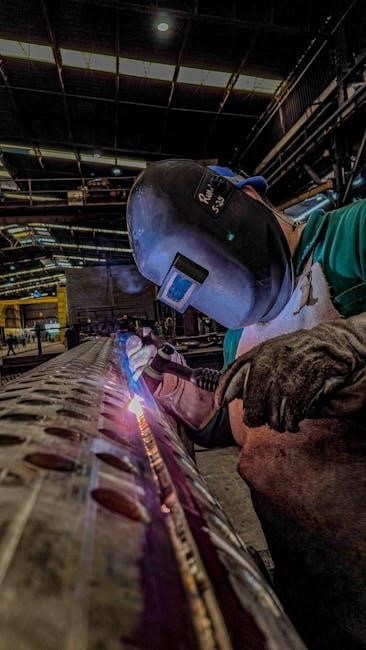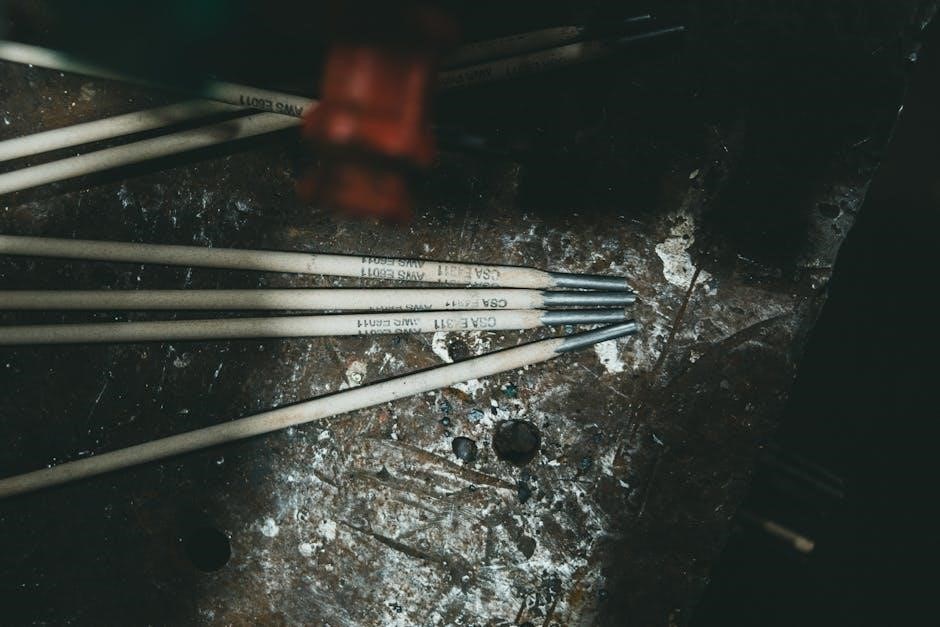A welding electrode chart is a comprehensive guide detailing electrode classifications‚ applications‚ and specifications. It aids in selecting the right electrode for specific welding processes and materials‚ ensuring optimal weld quality and safety. These charts are essential for welders to understand electrode properties‚ such as tensile strength‚ coating types‚ and compatible base metals. They are widely used in industries like construction‚ automotive‚ and manufacturing‚ providing a standardized reference for electrode selection and usage. The AWS (American Welding Society) classification system is a key component‚ offering detailed codes that define electrode characteristics and applications. Understanding these charts is crucial for achieving precise and durable welds in various industrial settings.
1.1 Purpose and Importance of Welding Electrode Charts
Welding electrode charts serve as essential guides for selecting the right electrodes for specific welding processes and materials. Their primary purpose is to ensure weld quality‚ safety‚ and compliance with industry standards. These charts provide detailed information on electrode classifications‚ mechanical properties‚ and compatible base metals‚ helping welders achieve optimal results. They are crucial for preventing defects like porosity or lack of fusion by matching electrodes to the job requirements. By standardizing electrode selection‚ these charts enhance efficiency and consistency in welding operations across various industries‚ making them indispensable tools for professionals and organizations alike.
1.2 Overview of the AWS Classification System
The AWS classification system is a standardized method for identifying welding electrodes based on their properties and applications. It uses a series of codes to denote factors such as tensile strength‚ welding position‚ and coating type. For example‚ in the E7018 electrode classification‚ “E” indicates it’s an electrode‚ “70” signifies tensile strength in thousands of pounds per square inch‚ “1” denotes welding position capabilities‚ and “8” refers to the coating and current type. This system ensures consistency and clarity‚ enabling welders to quickly identify the appropriate electrode for their specific needs‚ enhancing both safety and efficiency in welding processes.

Understanding AWS Electrode Classifications
AWS electrode classifications provide a structured system to identify electrode types based on tensile strength‚ welding positions‚ and coating characteristics‚ aiding in precise electrode selection for specific applications.
2.1 Structure of AWS Electrode Classification Codes
The AWS electrode classification codes are structured to provide clear identification of electrode properties. The codes typically start with an “E” prefix‚ indicating the electrode type. The following numbers and letters represent tensile strength‚ welding position capabilities‚ and coating characteristics. For example‚ in E7018-X‚ “70” denotes tensile strength in thousands of pounds per square inch‚ “1” indicates welding position versatility‚ and “8” refers to the coating type and current requirements. This systematic approach ensures electrodes are matched to specific base metals and welding processes efficiently‚ optimizing weld quality and performance.
2.2 Key Parameters in Electrode Classification
Key parameters in electrode classification include tensile strength‚ welding position‚ and coating type. Tensile strength‚ measured in thousands of pounds per square inch‚ determines the electrode’s suitability for specific applications. Welding position indicates where the electrode can be used‚ such as flat‚ horizontal‚ vertical‚ or overhead. Coating type influences penetration‚ slag characteristics‚ and current requirements. Additional parameters like current type (AC/DC) and shielding gas compatibility further refine electrode selection. These factors ensure electrodes meet mechanical property requirements and weld quality standards‚ making them essential for proper electrode specification and application in various welding processes.

Types of Welding Electrodes
Welding electrodes are categorized into mild steel‚ stainless steel‚ and low alloy steel types‚ each classified by tensile strength‚ coating‚ and application suitability‚ as detailed in electrode charts.
3.1 Mild Steel Coated Electrodes
Mild steel coated electrodes are versatile and widely used for joining carbon steel. They are classified under AWS specifications‚ such as E6013 and E7018‚ with classifications indicating tensile strength‚ coating type‚ and welding position capabilities. These electrodes are designed for shielded metal arc welding (SMAW) and flux-cored arc welding (FCAW). The E7018 electrode‚ for example‚ offers high tensile strength and deep penetration‚ making it ideal for critical joints. Proper selection ensures compatibility with base metals and desired mechanical properties‚ as outlined in welding electrode charts. Storage and handling guidelines are crucial to maintain electrode performance and weld quality.
3.2 Stainless Steel Electrodes
Stainless steel electrodes are designed for welding corrosion-resistant steels‚ offering excellent durability and resistance to environmental factors. AWS classifications like E308‚ E309‚ and E316 are common‚ with each grade tailored for specific stainless steel types. These electrodes are used in processes such as SMAW‚ GMAW‚ and GTAW. They provide strong‚ ductile welds with minimal corrosion risk. The E316 electrode‚ for instance‚ is ideal for welding austenitic stainless steels due to its high chromium and nickel content. Proper selection ensures compatibility with base metals‚ maintaining mechanical properties and corrosion resistance. Welding electrode charts detail these classifications‚ guiding users for optimal results.
3.3 Low Alloy Steel Electrodes
Low alloy steel electrodes are designed for welding high-strength‚ low-alloy (HSLA) steels‚ offering enhanced mechanical properties. AWS classifications like E7018 and E8018 are common‚ providing higher tensile strength and toughness. These electrodes are ideal for structural applications‚ such as bridges and heavy machinery‚ where strength and durability are critical. They often contain elements like nickel‚ chromium‚ and molybdenum to improve weld quality. Low alloy electrodes are resistant to cracking and offer good ductility‚ making them suitable for demanding environments. Proper selection ensures welds meet specific strength and toughness requirements‚ crucial for load-bearing structures.

Applications of Welding Electrodes
Welding electrodes are essential for various welding processes‚ including SMAW‚ FCAW‚ and GMAW. They are used across industries like automotive‚ construction‚ and manufacturing for joining metals efficiently and safely.
4.1 Shielded Metal Arc Welding (SMAW)
Shielded Metal Arc Welding (SMAW) is a widely used process employing a consumable electrode covered in flux. The flux protects the weld from atmospheric contamination‚ ensuring clean and strong joints. SMAW is versatile‚ suitable for various metals‚ and ideal for field repairs‚ construction‚ and maintenance due to its portability. The process relies on manual dexterity‚ making it a popular choice for skilled welders. Electrodes for SMAW are classified by the AWS system‚ which specifies tensile strength‚ welding positions‚ and coating types. Common electrodes like E7018 are used for high-strength applications‚ while E6013 is preferred for general-purpose welding. SMAW remains a cornerstone in many industries due to its reliability and adaptability.
4.2 Flux-Cored Arc Welding (FCAW)
Flux-Cored Arc Welding (FCAW) uses a tubular wire electrode filled with flux‚ providing excellent weld quality and versatility. The flux core shields the arc‚ reducing atmospheric contamination and improving weld consistency. FCAW is suitable for both automatic and semi-automatic welding‚ offering high deposition rates and deep penetration. It is widely used for welding steel‚ stainless steel‚ and nickel alloys‚ excelling in thick materials and harsh environments. AWS classifications for FCAW electrodes‚ such as E70T-1 and E308T‚ specify mechanical properties and applications‚ ensuring proper electrode selection for desired weld characteristics. FCAW is known for its efficiency and adaptability in various industrial applications.
4.3 Gas Metal Arc Welding (GMAW)
Gas Metal Arc Welding (GMAW)‚ also known as MIG welding‚ uses a continuous wire electrode fed through a welding gun. An inert gas shielding protects the arc‚ ensuring clean and precise welds. GMAW is highly efficient for thin materials and offers excellent control over weld penetration and appearance. It is widely used for welding steel‚ stainless steel‚ and aluminum. AWS classifications like ER70S-6 and ER308 provide specific electrode recommendations for different materials and desired weld properties. GMAW excels in automotive‚ aerospace‚ and industrial applications‚ offering high-speed‚ low slag‚ and consistent results. Proper electrode selection enhances weld quality and process efficiency.

Reading and Interpreting the Welding Electrode Chart
Understanding electrode classifications involves decoding AWS codes‚ which specify tensile strength‚ welding positions‚ and coating types. Matching electrodes to base metals ensures compatibility and optimal weld quality.
5.1 Decoding Electrode Classification Numbers

Electrode classification numbers‚ like E7018‚ provide critical information about the electrode’s properties. The “E” indicates it’s an electrode. The first two digits (e.g.‚ 70) represent tensile strength in thousands of pounds per square inch. The next digit (e.g.‚ 1) refers to welding positions and coating type. The suffix (e.g.‚ -X) may denote special properties. Understanding these codes helps match electrodes to specific base metals and welding processes‚ ensuring compatibility and desired weld properties. This system‚ standardized by AWS‚ is essential for accurate electrode selection and optimal welding outcomes. Proper decoding ensures safety and quality in welding applications.
5.2 Matching Electrodes to Base Metals and Welding Processes
Matching electrodes to base metals and welding processes ensures compatibility and optimal weld quality. The AWS classification system guides this process‚ as electrodes are designed for specific base metals like mild steel‚ stainless steel‚ or alloy steel. Factors such as tensile strength‚ welding position‚ and coating type must align with the base metal and process. For example‚ E7018 electrodes are ideal for high-strength steel‚ while E308 is suited for stainless steel. Proper matching prevents defects and ensures the weld meets mechanical and chemical requirements. Using the electrode chart helps in selecting the right electrode for the job‚ enhancing safety and efficiency in welding operations.

Best Practices for Using Welding Electrodes
Best practices involve selecting electrodes based on AWS classifications‚ ensuring proper storage‚ and maintaining humidity control. Always follow manufacturer guidelines for optimal welding performance and safety.
6.1 Selecting the Right Electrode for the Job
Selecting the right electrode involves understanding the AWS classification system and matching electrodes to the base metal and welding process. The AWS code indicates the electrode’s tensile strength‚ welding position‚ and coating type. For example‚ E7018 electrodes are suitable for high-strength‚ low-alloy steel welds in flat and horizontal positions. Always consider the mechanical properties required for the weld‚ such as impact strength and ductility. Refer to the welding electrode chart to ensure compatibility with the base metal and welding process‚ like SMAW or FCAW. Proper selection ensures optimal weld quality‚ durability‚ and safety.
6.2 Storage and Handling of Welding Electrodes
Proper storage and handling of welding electrodes are critical to maintain their quality and performance. Electrodes should be stored in a cool‚ dry place‚ away from direct sunlight and moisture. Low-hydrogen electrodes‚ in particular‚ require strict moisture control to prevent hydrogen cracking. Electrodes should be stored in their original‚ sealed packaging until use. Once opened‚ they should be re-dried in a drying oven at the recommended temperature and time. Handling electrodes with clean‚ dry gloves or tongs prevents contamination. Always follow the manufacturer’s guidelines for storage and handling to ensure optimal weld quality and safety. Proper care extends electrode lifespan and reliability.
Understanding welding electrode charts is essential for safe‚ efficient‚ and high-quality welding. Proper electrode selection and use ensure strong‚ durable welds‚ meeting industrial standards and requirements.
7.1 Summary of Key Points
7.2 Importance of Proper Electrode Selection
Proper electrode selection is critical for achieving desired mechanical and chemical properties in welds. It ensures compatibility with base metals‚ preventing defects like porosity or cracking. Using electrodes with appropriate tensile strength and coating types enhances weld quality and durability. Incorrect selection can lead to weaker joints‚ corrosion‚ or failure under stress. Adhering to classifications like AWS ensures welds meet industry standards‚ optimizing performance and safety in applications across various industries. This underscores the necessity of referring to welding electrode charts for informed decisions‚ avoiding costly repairs or potential hazards.